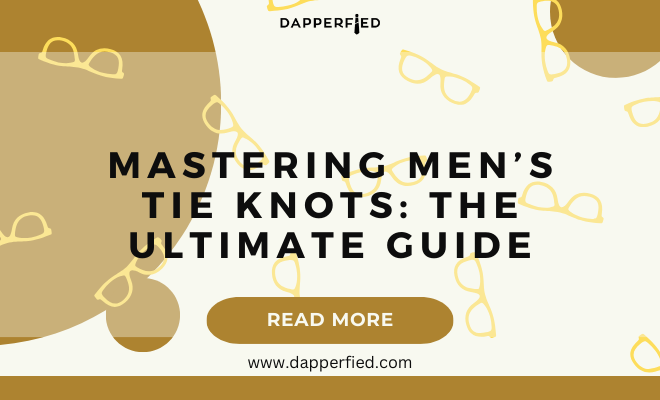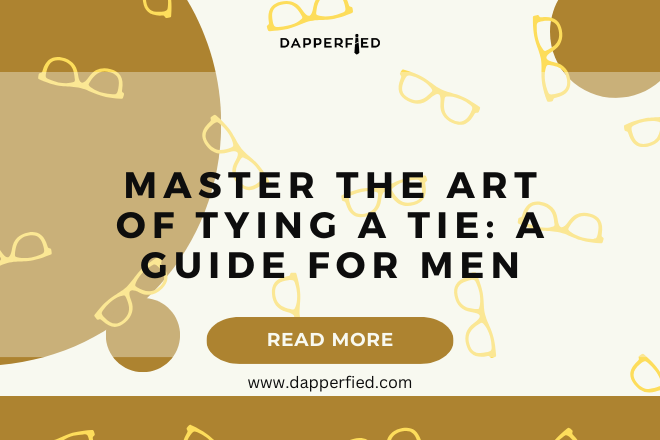
Men's Style
Mastering Men’s Tie Knots: The Ultimate Guide
Tie knots have been a staple of men’s fashion for centuries, with their origins dating back to the 17th century during the Thirty Years’ War in France. Croatian mercenaries, serving in the French army, wore a piece of cloth around their necks to keep their jackets closed. This caught the attention of the Parisians, who called it a “cravat” after the Croatians. The trend quickly spread throughout Europe, and tie knots became a symbol of elegance and sophistication.
Over time, tie knots evolved from simple neck cloths to intricate and stylish knots. In the 19th century, the Industrial Revolution led to the mass production of ties, making them more accessible to the general public. This also sparked a surge in creativity and innovation in tie knot styles, with different cultures and fashion movements contributing to the variety of knots we see today. From the classic Windsor knot to the modern Eldredge knot, tie knots have become an essential accessory for men’s formal attire, reflecting their personality and style.
Key Takeaways
- Tie knots have a long history dating back to the 17th century, evolving from cravats to the modern necktie.
- There are various types of tie knots, each with its own unique style and level of formality, such as the Windsor, Half-Windsor, and Four-in-Hand knots.
- Tying a Windsor knot involves several steps, including crossing the wide end over the narrow end and pulling it up through the loop.
- When choosing a tie for different occasions, consider the color, pattern, and fabric to complement the outfit and the event’s formality.
- Achieving a perfectly symmetrical knot requires attention to detail, such as adjusting the length and width of the tie and ensuring the knot is centered.
Understanding Different Types of Tie Knots
There are numerous tie knots to choose from, each with its own unique style and level of complexity. The four-in-hand knot is one of the most popular and easiest to tie, making it a versatile choice for everyday wear. The Windsor knot, on the other hand, is a wider and more symmetrical knot that exudes a sense of formality and elegance. For a more contemporary look, the Pratt knot offers a sleek and streamlined appearance, while the Eldredge knot is a bold and intricate choice for those who want to make a statement.
Other notable tie knots include the Half-Windsor, the Trinity knot, and the Bow tie knot, each with its own distinct characteristics and level of difficulty. Understanding the different types of tie knots allows individuals to choose the most suitable style for their outfit and personal preference. Whether it’s for a formal event, a business meeting, or a casual gathering, selecting the right tie knot can elevate one’s overall look and leave a lasting impression.
Step-by-Step Guide to Tying a Windsor Knot
The Windsor knot is a classic and timeless choice that complements wide-collar shirts and suits. To achieve this sophisticated knot, start by draping the tie around your neck with the wide end on the right and the narrow end on the left. Cross the wide end over the narrow end, bringing it underneath and up through the loop between the collar and the tie. Then, bring the wide end down and across the narrow end to the right.
Next, bring the wide end up through the loop again, this time from underneath. Then, pull it down through the knot in front and tighten it by holding the narrow end and sliding the knot up to the collar. Adjust the knot by holding it with one hand and pulling on the narrow end with the other until it’s centered and snug. The result is a symmetrical and elegant Windsor knot that adds a touch of refinement to any ensemble.
Tips for Choosing the Right Tie for Different Occasions
| Occasion | Recommended Tie |
|---|---|
| Formal Business Meeting | Solid color silk tie |
| Job Interview | Subtle patterned tie |
| Wedding | Classic silk tie |
| Cocktail Party | Textured or patterned tie |
| Casual Gathering | Knit or cotton tie |
Selecting the right tie for different occasions is essential for creating a polished and put-together look. For formal events such as weddings or black-tie affairs, opt for silk ties in classic colors like black, navy, or burgundy, paired with a sophisticated Windsor or Half-Windsor knot. Business settings call for conservative yet stylish ties in solid or subtle patterns, complemented by a Pratt or Four-in-Hand knot for a professional appearance.
Casual gatherings allow for more creativity and experimentation with tie choices. Consider incorporating textured or patterned ties in vibrant colors to add personality to your outfit, paired with a simple Four-in-Hand or Pratt knot for a relaxed yet stylish look. When choosing ties, consider the color coordination with your shirt and suit, as well as the overall aesthetic you want to convey. By selecting the right tie for different occasions, you can enhance your style and make a lasting impression wherever you go.
How to Achieve a Perfectly Symmetrical Knot
Achieving a perfectly symmetrical tie knot requires attention to detail and precision in tying technique. Start by ensuring that the length of the wide end is longer than the narrow end when draping it around your neck. This will allow for proper adjustment and balancing of the knot later on. When tying the knot, make sure to maintain equal tension on both ends to prevent an uneven or lopsided appearance.
After tightening the knot, adjust it by holding the narrow end and sliding the knot up to the collar while gently pulling on the wide end to create a symmetrical shape. Take your time in adjusting and aligning the knot until it sits perfectly centered and parallel to the collar. By following these steps and paying attention to detail, you can achieve a perfectly symmetrical tie knot that enhances your overall look with elegance and sophistication.
Troubleshooting Common Tie Knot Issues

Tying a tie knot can sometimes present challenges such as uneven lengths, twisted knots, or difficulty in achieving symmetry. To address uneven lengths, start by adjusting the initial placement of the wide end when draping it around your neck to ensure that it’s longer than the narrow end. If you encounter twisted knots during tying, carefully untangle the fabric and start over to create a smooth and even knot.
For issues with achieving symmetry, take your time in adjusting and aligning the knot by holding it with one hand and gently pulling on the narrow end with the other until it’s centered and parallel to the collar. If necessary, re-tie the knot using precise movements to achieve a balanced and symmetrical appearance. By troubleshooting common tie knot issues with patience and attention to detail, you can overcome any challenges and create a flawless knot that enhances your overall style.
Advanced Techniques for Mastering Tie Knots
For those looking to elevate their tie knot skills, there are advanced techniques that offer unique and intricate styles. The Trinity knot, also known as the Love knot, is an elaborate three-way knot that creates an eye-catching and complex design. To master this technique, follow step-by-step instructions carefully to create each loop and fold with precision.
The Eldredge knot is another advanced technique that involves multiple wraps and folds to achieve a striking and unconventional look. This intricate knot requires patience and practice to perfect, but it offers a bold and distinctive style for those who want to make a statement with their tie knots. By exploring advanced techniques for mastering tie knots, individuals can expand their repertoire of styles and showcase their creativity through their choice of knots.

In conclusion, tie knots have a rich history dating back centuries and have evolved into an essential accessory for men’s fashion. Understanding different types of tie knots allows individuals to choose styles that complement their outfits and personal preferences. Tying a Windsor knot requires attention to detail and precision, while selecting the right tie for different occasions is essential for creating a polished look. Achieving a perfectly symmetrical knot involves careful adjustment and balancing of tension on both ends. Troubleshooting common tie knot issues requires patience and precision in tying technique. Advanced techniques offer unique and intricate styles for those looking to elevate their tie knot skills. Mastering tie knots is an art form that allows individuals to express their personal style with elegance and sophistication.
If you’re interested in learning more about men’s fashion, you might want to check out this article on suit separates. It’s a great read for those looking to mix and match their wardrobe to create different looks with their suits.
FAQs
What are the most popular tie knots for men?
The most popular tie knots for men include the Four-in-Hand knot, the Windsor knot, the Half-Windsor knot, and the Pratt knot. Each knot has its own unique style and level of formality.
How do I tie a Four-in-Hand knot?
To tie a Four-in-Hand knot, start with the wide end of the tie on the right and the narrow end on the left. Cross the wide end over the narrow end, then bring it under and over the narrow end. Pull the wide end through the loop around your neck, then bring it across the front and pull it through the loop again. Tighten the knot and adjust as needed.
What is the difference between a Windsor knot and a Half-Windsor knot?
The Windsor knot is a larger, more symmetrical knot that is best suited for wide spread collars and formal occasions. The Half-Windsor knot is a smaller, more versatile knot that works well with most shirt collars and is appropriate for both formal and casual settings.
How do I tie a Pratt knot?
To tie a Pratt knot, start with the wide end of the tie on the right and the narrow end on the left. Cross the wide end over the narrow end, then bring it up and through the loop around your neck. Bring the wide end down and to the left, then bring it up and through the loop again. Tighten the knot and adjust as needed.
What type of tie knot should I use for different collar styles?
For wide spread collars, the Windsor knot is a good choice. For most other collar styles, the Four-in-Hand knot or the Half-Windsor knot are versatile options that work well.














